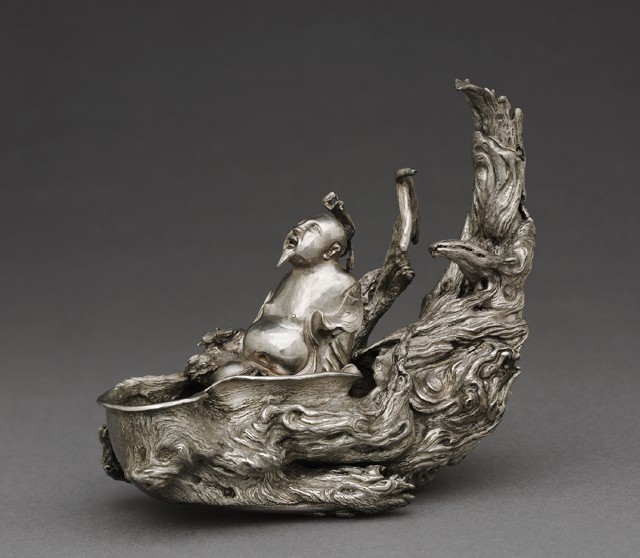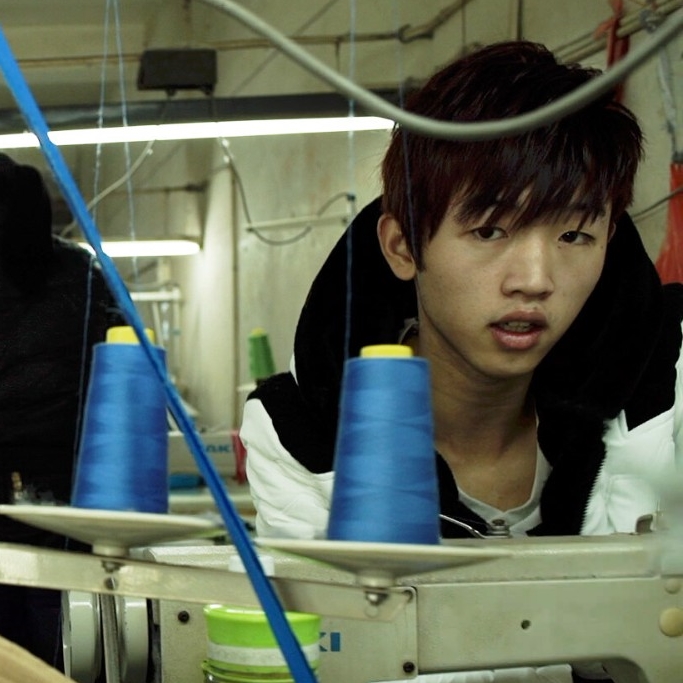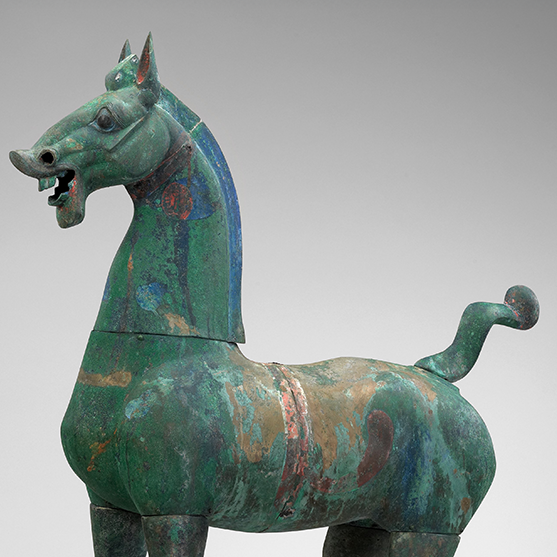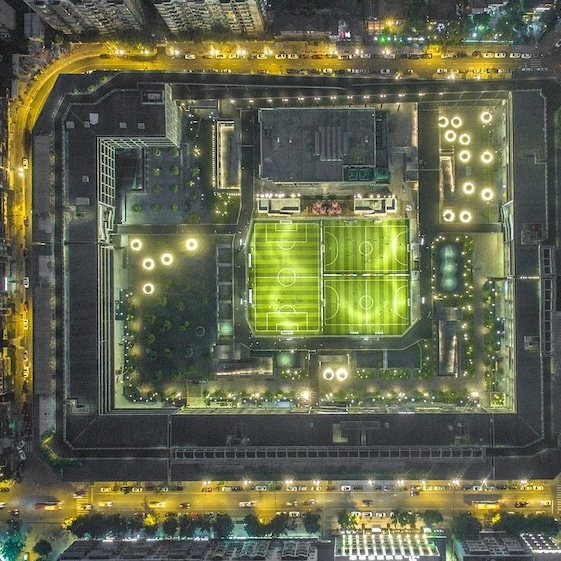 Twelve Views of Tiger Hill, Suzhou: The Thousand Buddha Hall and the Pagoda of the “Cloudy Cliff” Monastery after 1490. Shen Zhou (Chinese, 1427–1509). Album leaf; ink on paper or ink and light color on paper; 36.5 x 49.9 cm. Leonard C. Hanna Jr. Fund, 1964.371.7
Twelve Views of Tiger Hill, Suzhou: The Thousand Buddha Hall and the Pagoda of the “Cloudy Cliff” Monastery after 1490. Shen Zhou (Chinese, 1427–1509). Album leaf; ink on paper or ink and light color on paper; 36.5 x 49.9 cm. Leonard C. Hanna Jr. Fund, 1964.371.7
The Cleveland Museum of Art presents China’s Southern Paradise: Treasures from the Lower Yangzi Delta, a landmark exhibition that explores the historical and cultural riches of a pivotal region known as Jiangnan. The exhibition—the first in the West to focus on this area—features more than 200 objects from Neolithic times to the 18th century, ranging from jade, silk, prints, and paintings to porcelain, lacquer, and bamboo carvings, all of which were related to Jiangnan which has remained one of China’s wealthiest, most populous, and agriculturally fertile lands.
 Imaginary Journey through Xiao-Xiang (瀟湘臥游圖), c. 1170. Li (李) (Chinese). China, Southern Song dynasty (1127–1279). Handscroll; ink on paper; 30.3 x 400.4 cm. Tokyo National Museum, TA-161, National Treasure
Imaginary Journey through Xiao-Xiang (瀟湘臥游圖), c. 1170. Li (李) (Chinese). China, Southern Song dynasty (1127–1279). Handscroll; ink on paper; 30.3 x 400.4 cm. Tokyo National Museum, TA-161, National Treasure
Jiangnan’s lush, green scenery inspired poets and artists to conceive it as heaven on earth. For millennia, it has been an area of rich agriculture, extensive trade, and influential artistic production. Art from Jiangnan—home to such great cities as Hangzhou, Suzhou, and Nanjing, as well as to hilly picturesque landscapes stretched along rivers and lakes—has defined the image of traditional China for the world.
 Incense Burner in the Form of a Duck (青白釉鴨形香爐), 1100–1200. South China, Song dynasty (960–1279). Porcelain with underglaze molded and carved decoration, qingbai (blue-white) ware; h. 19.1 cm. Art Institute of Chicago, Gift of Russell Tyson, 1941.963
Incense Burner in the Form of a Duck (青白釉鴨形香爐), 1100–1200. South China, Song dynasty (960–1279). Porcelain with underglaze molded and carved decoration, qingbai (blue-white) ware; h. 19.1 cm. Art Institute of Chicago, Gift of Russell Tyson, 1941.963
 Service with Bamboo, Plum Blossoms, Butterflies, and Birds (銀鎏金鏨花梅竹雀蝶紋盞盤), 1200s. China, Southern Song dynasty (1127–1279). Silver with chased and punched decoration and gilding; diam. 11.1–19.1 cm. The Metropolitan Museum of Art, The Vincent Astor Foundation Gift, 1997, 1997.33.1–3, 5–6
Service with Bamboo, Plum Blossoms, Butterflies, and Birds (銀鎏金鏨花梅竹雀蝶紋盞盤), 1200s. China, Southern Song dynasty (1127–1279). Silver with chased and punched decoration and gilding; diam. 11.1–19.1 cm. The Metropolitan Museum of Art, The Vincent Astor Foundation Gift, 1997, 1997.33.1–3, 5–6
Through major loans from more than 40 institutions around the world and selections from the Cleveland Museum of Art’s world-renowned collection of Chinese art, China’s Southern Paradise explores the coastal region south of the Yangzi River, where the earliest remains of cultivated rice were found. Key loans from seven Chinese institutions, including the Beijing Palace Museum, the Shanghai Museum, and the Nanjing Museum, bring rarely seen objects to the US that illustrate how Jiangnan gained a leading role in China’s artistic production and succeeded in setting cultural standards. The exhibition also includes objects from Japan, Europe, Canada, and throughout the United States, brought together for the first time, some of which have never been presented to the public before.

Elegant Gathering of Five Suzhou Natives (detail), 1368–1644. China, Ming dynasty (1368–1644). Handscroll; color on silk; 37.4 x 188.2 cm. Shanghai Museum  Raft Cup, 1345. Attributed to Zhu Bishan (Chinese, c. 1300–after 1362). Hammered silver soldered together, with chased decoration; overall: 16 cm. The Cleveland Museum of Art, John L. Severance Fund, 1977.7
Raft Cup, 1345. Attributed to Zhu Bishan (Chinese, c. 1300–after 1362). Hammered silver soldered together, with chased decoration; overall: 16 cm. The Cleveland Museum of Art, John L. Severance Fund, 1977.7
“So much of what we associate with traditional China today—such as rice, silk and lacquer production, color printing, garden culture, landscape painting—either originated or flourished in the Jiangnan region,” said Clarissa von Spee, the show’s curator and the James and Donna Reid Curator of Chinese Art, Interim Curator of Islamic Art and Chair of Asian Art at the Cleveland Museum of Art. “To bring these rare, unique treasures together from around the world provides a once-in-a-lifetime opportunity for visitors, nationally and abroad, to witness the richness and unsurpassed quality of art from a part of China that is still associated with natural beauty, elegance, high culture, and erudition. Jiangnan imagery and goods that reached 18th-century Europe shaped our idea of China more than any other region.”
The Exhibition is on view through January 7, 2024, in the Kelvin and Eleanor Smith Foundation Exhibition Hall at the Cleveland Museum of Art.
Courtesy of the Cleveland Museum of Art, for further reading please visit https://www.clevelandart.org.




























